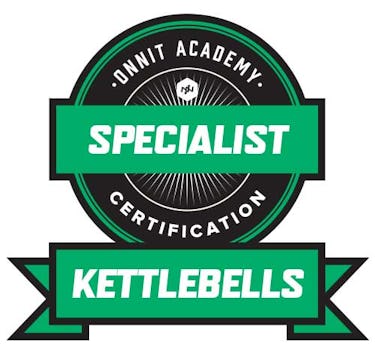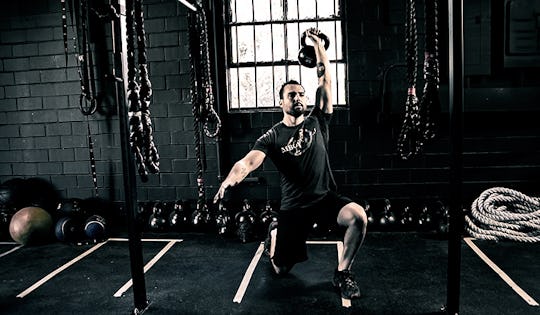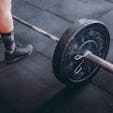
The Kettlebell Specialist Course was created to give the user a simple, powerful approach to learning and teaching proper kettlebell use.
The Onnit Academy brings together the best fitness experts from all over the world, and if you can’t be here to learn from them in person, using this website is the next best thing.
In an effort to help you become better acquainted with our Academy Master trainers and the unique skills they offer, we’re going to introduce you to them one at a time.
In honor of “Kettlebell Week” here at the academy, we bring you the following interview with Onnit’s Master Kettlebell Trainer, Marcus Martinez. A longtime kettlebell devotee who has studied under legends such as Pavel Tsatsouline and Steve Maxwell, Martinez works out of Brea, Calif., where he records workout videos for our On Demand channel and Youtube. You can catch up with Martinez at our Kettlebell Certification as well, coming to a city near you.
Marcus Martinez
Age: 32
Height: 6’0
Weight: 185 pounds
Hometown: Brea, CA
Years training: 17
Fun fact: “Growing up, I wanted to be Batman—but keep my parents.”
Onnit: How did you first become interested in fitness?
Martinez: Do you remember the show Guts on Nickelodeon? It was all about physical competitions. The kids had to climb stuff all the time, like the Crag [a man-made mountain], and I realized right then, “Man, I have to be in shape.” And then I saw the movie Kickboxer with Jean-Claude Van Damme. I would work out in my room and do pushups to look like he did in the movie.
I also wanted to be Batman so I thought I had to do pull-ups because Batman climbs buildings. But it wasn’t until I was in my late teens that I started taking fitness seriously, and it was for tennis. I played in college. I was never into bodybuilding or powerlifting, I just wanted to know how I could move, be faster, and be stronger on the court without getting bulky.
What kind of training were you doing then?
Pretty much just body-weight circuits and machine circuits, or I’d set up a bunch of dumbbells. I never did body-part workouts, always full body. I always gravitated toward the faster-paced, higher-intensity circuit type training. I think I went for the body-weight stuff because at the time I didn’t necessarily like going to traditional gyms. I preferred stuff you could do on your own in your back yard. I used to jump rope every day, so you’d think I’d have bigger calves now [laughs].
When did you get into kettlebells, and what attracted you to them?
I was still in the middle of my college tennis days and I came across an article by Mike Mahler. I liked the movements he was doing. But in those days a kettlebell was like $250, so I thought I’d just do the same movements with a dumbbell. I learned to do cleans, presses, windmills, and getups, and after a while I thought, “OK, there’s something to this.” But I could tell that doing those moves with the kettlebell is what made them unique.
I finally put the money down and got the kettlebell, and down the rabbit hole I went. I read everything I could by Mahler, Pavel, Steve Cotter. I was all in. I trained under the RKC, the IKFF, and Steve Maxwell’s course.
In your opinion, what is the biggest advantage of kettlebells over other implements?
At the time, for me, it was being able to do everything—exercise-wise—with one or two kettlebells. But now I’m obsessed with kettlebell flows. The fact that kettlebells allow you to move from position to position seamlessly is so powerful. You can go from a snatch to a clean to a squat. As a general strength and conditioning tool, it’s so cool that I can get my athletes to do these movements without having to put the weight down.
A great kettlebell flow looks like art, like a dance. You burn a lot of calories and really work the grip because you constantly have to hold on—it’s unparalleled for grip strength. The body awareness while you go from position to position is super powerful for athletes. They can get comfortable in uncomfortable positions and different planes of motion while weighted. Now put them into those positions in real life and they’re fine because they’ve already done it with extra load. Nothing—no muscle or body part—works by itself with kettlebells. Doesn’t matter if you’re a tennis player, a baseball player, or kickboxer—they’re all going to benefit from a stronger grip, more mobile shoulders, and a stronger core.
Is there any one particular sport skill or activity that you think kettlebells are especially good at developing?
If I had to pick one type of athlete that I think kettlebells would do the most for it would be a jiu-jitsu player. Because you hit everything you need for that sport with this tool. Grip, rotational power, hip mobility, and the awareness of your body to go from tension to fluidity.
What should we look for in a kettlebell?
You want a solid iron weight. One piece. You don’t want anything with a rubber bell and a plastic handle. Make sure the grip is smooth enough—no need for your hands to get ripped up. Avoid gimmicky stuff and keep it simple.
The problem with bells with concave faces is you won’t be able to go from movement to movement seamlessly without thinking. You have to stop, turn the bell over before you clean it. And they’re kind of janky. You miss out on the feel of having a real kettlebell racked or overhead, which is part of what lets you progress. It’s worthwhile to learn the positions, transitions, progressions, and regressions using a real kettlebell so you don’t have to form the tool around you. You can form around the tool and do limitless things with it.
One thing that intimidates people about kettlebell work is the classic kettlebell clean. How do you teach people to perform it without smacking the weight into their forearm?
That’s one of my favorite things to teach and the first thing I do with people. To start, I have people take a very light bell and do a half-kneeling curl—get into a lunge position with one knee on the floor and curl the bell from the floor using the other hand for assistance. Let the kettlebell slide in your hand and spin around the wrist, not flop over it. From there, we’ll go into a half-kneeling dead start, which is just a curl and spin with one hand, unassisted. Then we can stand up and do a dead-start clean. This is a clean where the weight starts from a dead stop on the floor before each rep and you have to bend your hips back and pick it up. Now it’s starting to look like a real clean.
After this, we can do the clean from a full standing position. Bend the hips back to let the weight travel between the legs and then extend the hips to clean the weight—but we use assistance from the other hand again to ensure the kettlebell spins around the arm. When that feels comfortable, we can finally attempt a full clean.
How long does it take the average person to learn a proper clean?
You can do it easily within a couple weeks. Most people have the strength but not the technique. But with good coaching, I have most people doing some substantial weight on cleans within 30 days.
How do you program the kettlebell lifts?
Pretty much the same way you would with barbells and dumbbells. The obvious downside is you can’t have that incremental growth that you do with barbells and dumbbells, because kettlebells don’t go up by five or 10-pound increments. So I like to do a lot more volume work. I do a lot of heavy lifts, 3–5 reps, or conditioning with EMOMs [Every Minute On the Minute], density rounds.
You can still do 4 sets of 10 and other traditional rep schemes, but what you lose in the ability to build up incrementally you gain in effective conditioning.
I’ll do heavy two-hand anyhows, two-hand getups. Then I’ll do high volume stuff, like German Volume Traning— 10 sets of 10 on cleans, snatches, squats. When I nutted up and did that for a while, that was the fastest muscle growth I’ve seen.
The swing is probably the most commonly-seen kettlebell exercise, but most people can’t do it properly. How do you progress clients to doing proper swings?
Get the hinge down first. Most people don’t know how to do that without the knees bending forward or buckling in. Then go to the chest-supported swing [holding the bell against your chest while performing a hinge]. Then explosive deadlifts, keeping the bell vertical. Once they understand how to transfer energy and absorb shock from the drop of lowering the deadlift, we can go into single-rep swings. I have people start by focusing on all the nuances of the swing with just one rep, rather than doing 20 reps wrong. The typical client can learn to do a perfect swing in a week.
This progression is covered in Onnit’s Foundations Certification.
Some people have trouble understanding the form on kettlebell lifts in general. What tips would you give them to be safe?
Stay connected to the ground. Most people who get injured with kettlebells get hurt because they lose balance trying to catch a weight they should have aborted. Stay aware of your core—everything in your middle—because that’s where everything starts and ends. Always remember to keep a long spine. Whether it’s a squat, hinge, or rotation, keeping your head, spine, and pelvis straight and aligned is key.
How did you come to Onnit?
I was invited out to a certification course in 2014. I immediately liked the community-driven, non-dogmatic approach of the company. Then [Chief Fitness Officer] John Wolf approached me about being the kettlebell Master coach. So many other kettlebell communities are elitist and dogmatic in their approach. I don’t like the idea of having to do things a certain way and that way alone. Onnit was the first place that said you can be this and be that. I could train in different ways, talk to different experts. I became the official kettlebell Master Trainer in November 2016.
What are your favorite kettlebell lifts?
I like rotational cleans, traditional cleans. Doing a 170-pound kettlebell clean with one arm is just stupid fun. I love juggles. I can flip one kettlebell around my back, between my legs. It’s like a flow but I let the kettlebell go and catch it. I can do them blindfolded, literally.
Have you trained any celebrities with kettlebells?
Jessica Alba. Full disclosure, she’s a cousin of mine. She was never interested in training and then one day I randomly got a message from her saying she loves the stuff I’ve been doing on Youtube and she wants to try it. We focused on half-kneeling windmills and she worked up to two-hand swings with 35 pounds—a weight that most guys start with.
And look at her. Women who use kettlebells aren’t going to get bulky. You’re not going to stimulate substantial muscle growth with a 12 or 20-pound kettlebell. You’ll burn calories and get stronger but you won’t stimulate growth dramatically in one particular area.
What are your top 3 kettlebell moves everyone should add to their training?
I’d go with the half-kneeling windmill, one-arm swing, and bottoms-up reverse lunge.
I love that windmills build shoulder stability and strength without the wear and tear of presses and jerks. They build a lot of core strength and flexibility too. General body awareness.
The one-arm swing builds glute and ham strength, speed, and anti-rotation, because you’re trying not to let the bell pull you to one side. That helps athletes who are trying to punch harder or run faster.
The bottoms-up reverse lunge works shoulder strength, grip strength, core, legs—and it gives you a nice biceps pump too.
You could do a circuit with all three of them. Do them continuously for 10–15 minutes and try to beat the total number of rounds you do each workout.
1. One-Arm Swing x 6 each side
2. Bottoms-Up Reverse Lunge x 7 each side
3. Half-Kneeling Windmill x 5 each side
The bottoms-up is going to be the limiting factor, so guys can use a 12-kilo bell for that and 20 kilos for the swing and windmill. I’d suggest an 8-kilo and 12-kilo for ladies.
What is the craziest thing you’ve ever seen done with a kettlebell?
John Wild Buckley, of Orange Kettlebell Club, is 6’7”, 300 pounds. I saw him hold a 40-kilo kettlebell in the webbing between his thumb and palm while he held a 32-kilo on his pinkie and do a double kettlebell lift.
How has kettlebell training helped you most?
I have three kids—a seven, five, and three-year-old. Kettlebell lifting carries over to wrestling with and throwing around children like nothing else [laughs]. My dad had me when he was already over 40, so he wasn’t able to be very active with me when I was growing up.
I decided from an early age that I wanted to be able to be active with my kids. If not outlast them, at least go as hard as they can [laughs].
I’ve got them doing kettlebell lifts, pushups, and pullups too.
Now for some random questions. Favorite movie?
Snatch.
Is that because you’re obsessed with kettlebells?
Oh my God, I never even put that together! [laughs] That was the first DVD I ever bought.
Action movie?
Kickboxer. I’m not sure if I’m excited about the remake though. On the one hand it’s still Kickboxer, but there’s the purist in me that says don’t touch something that was already great.
Favorite book?
The Tao Te Ching, by Lao Tzu. It’s a guide to Taoism. I still read that book everyday.
The Four Agreements by Don Miguel Ruiz is another one. It’s four agreements you make with yourself that will make your life flow.
Get workouts from Marcus on Onnit’s On Demand channel and follow him on Instagram, @kettlebellexercises

)






